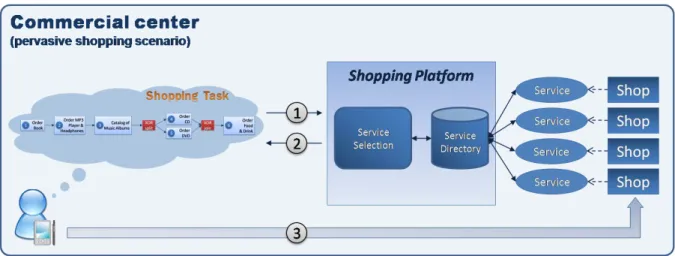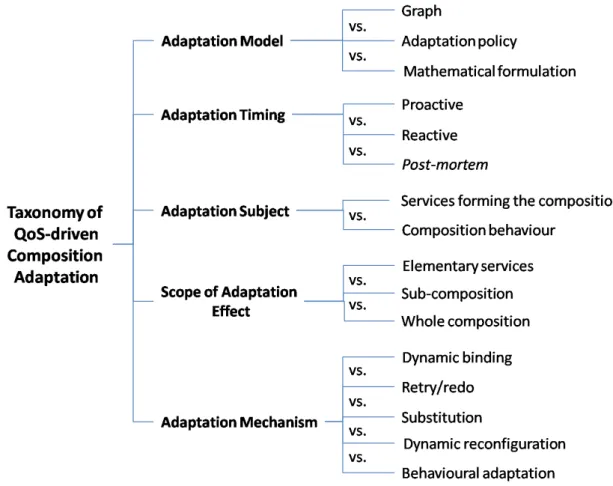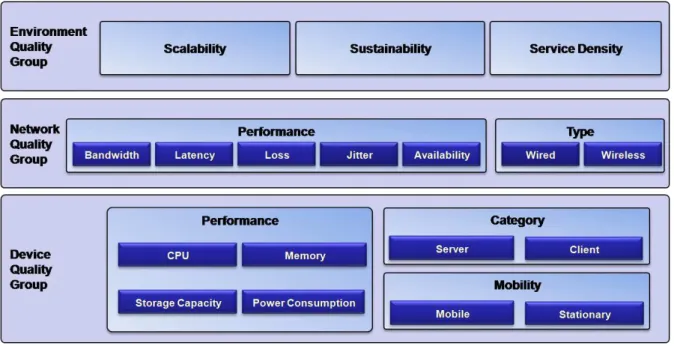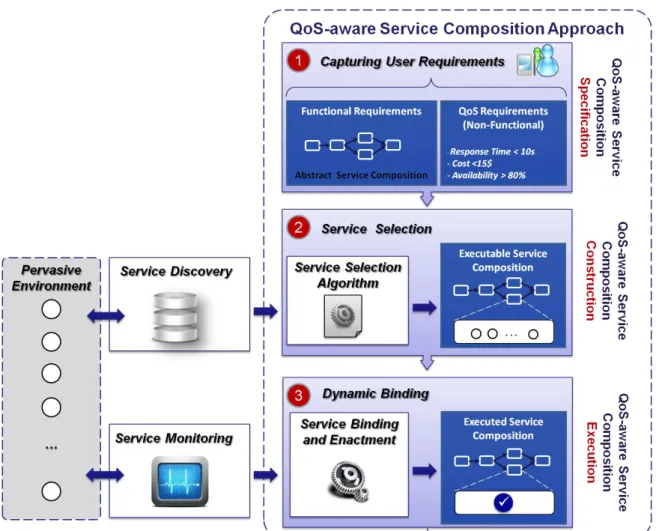Using his cell phone, Bob can schedule his doctor's appointment while he is in the hospital waiting room. According to our scenario, Bob can order his desired items using his mobile phone while staying in the lounge hall of the commercial center.
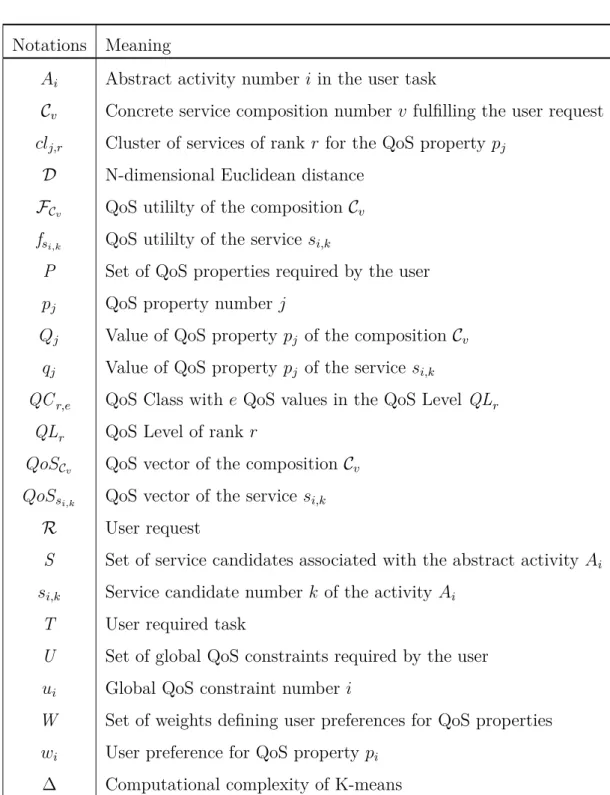
QoS-enabling specifications
QoS-aware service discovery
QoS-aware service composition
QoS-driven composition adaptation
To address the above QoS issues in pervasive environments, we next introduce a QoS-aware service-oriented middleware solution for pervasive environments. Chapter II is devoted to the state of the art of QoS-aware service-oriented middleware.

Taxonomy of QoS models
QoS models can be divided into syntactic and semantic models with respect to their ability to express the semantics of QoS concepts. For this reason, semantic QoS models represent a more suitable solution for QoS description in pervasive environments.
Quality-Based Service Description (QSD)
The authors define QoS-aware service compositions using three layers: (i) service layer, (ii) choreography layer, and (iii) orchestration layer. QoS-aware service discovery means matching the required task and associated QoS requirements with services available in the environment.
Service assembly approach
The goal of QoS-aware service composition is to select and build service compositions that: (i) meet the user's QoS requirements, and (ii) maximize the QoS offered. The graph-based and AI scheduling approaches do not support service composition structured with respect to composition patterns (sequence, parallel, choice, loop), they only produce simple sequences of services that can fulfill the user's task.
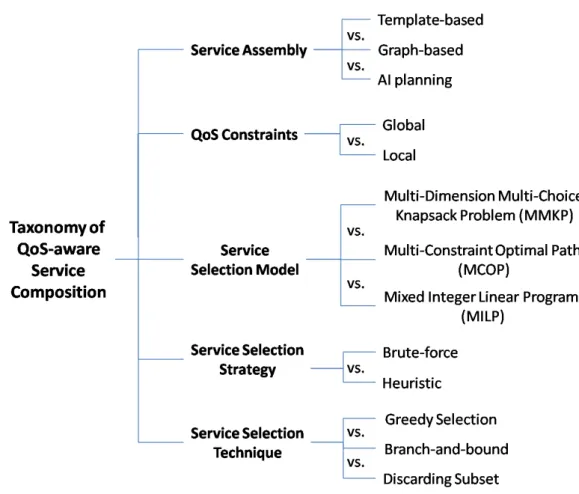
Scope of QoS constraints
QoS-aware service selection models
By abstracting service candidates and the control/data flow between them into nodes and edges, respectively, QoS-aware service selection can be expressed as an MCOP problem that aims to traverse the graph of service candidates to find a path with the highest QoS utility and satisfy global QoS restrictions. QoS-aware selection can be expressed as a mixed-integer linear program by defining the global QoS for the entire service composition as an objective function and global QoS constraints as linear constraints.
QoS-aware service selection strategies
PICO [Kalasapur et al., 2007] models QoS-aware service selection as a variant of MCOP called multi-constrained path selection (MCPS), which aims to select paths in a multi-constrained service graph. For example, the selection algorithm proposed by the Aura project [Sousa et al., 2006] uses the QoS utility and the ratio of required resources as heuristics to determine near-optimal compositions, while PICO [Kalasapur et al., 2007] uses two heuristics. algorithms (i.e., the extended Dijkstra algorithm and the Bellman Ford algorithm [Xiao et al., 2004]) to solve QoS-aware service selection formulated as an MCPS problem.
QoS-aware service selection techniques
The goal of QoS-based composition adaptation is to adapt the current QoS-aware composition of services to ensure that QoS requirements are met and/or to optimize the QoS delivered to users [Kazhamiakin et al., 2010]. Based on this survey, we identify our main criteria for evaluating QoS-based composition adaptation approaches (see Figure II.4): (i) adaptation model, (ii) adaptation time, (iii) adaptation entity, (iv) mechanism adaptation and (v) the extent of the adaptation effect [Kazhamiakin et al., 2010].
Adaptation model
The authors introduce a set of criteria for comparing adaptation approaches (the survey is of interest to the reader who would like to explore further). Based on the proposed policy, the authors introduce an adaptation approach that selects and composes actions (i.e., related to users, user tasks, environment, and services) to adapt the composition of an ongoing service.
Adaptation timing
Zhang et al., 2007] defines an adaptation policy that makes it possible to express the behavior of users, user tasks, the environment and services available in the environment according to the event-state-action paradigm. The Aura project [Sousa et al., 2006] presents a mathematical formulation that expresses adaptation as an optimization problem.
Adaptation subject
It is characterized by a large gap between adaptation triggering and adaptation execution [Kazhamiakin et al., 2010]. In general, the post-mortem adaptation is achieved by creating deep changes in the ongoing service composition, such as re-designing the composition and changing its behavior.
Scope of adaptation effect
Adaptation mechanism
These tables are structured with respect to the surveyed QoS-aware service-oriented middleware functionalities and their associated taxonomies. QoS-aware service selection according to end-to-end QoS requirements has already been addressed in the literature [Yu et al., 2007].
QoS Core ontology
The infrastructure QoS ontology also defines quality factors related to the capabilities of mobile devices and the connectivity of wireless networks. For the sake of visibility, Figure III.2 does not show further concepts of the QoS core ontology, such as those needed to evaluate quality factors such as MetricType and Conformity.
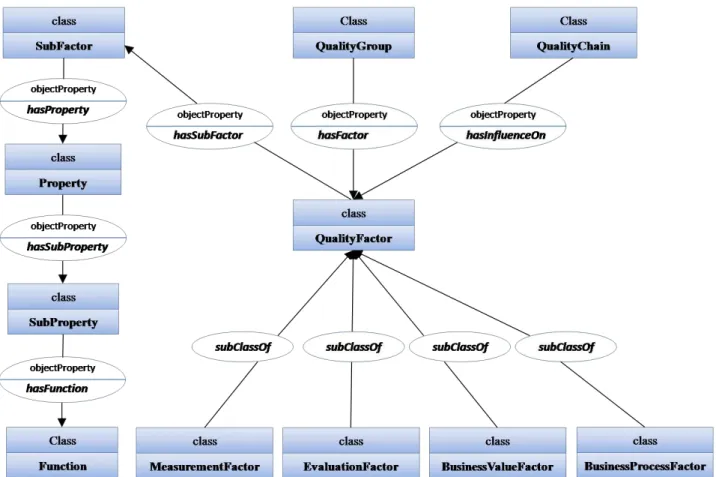
Infrastructure QoS ontology
It partially shows the ability of an environment to satisfy user requests, i.e., the higher the service density, the higher the probability of fulfilling user tasks. Finally, scalability refers to the ability of the environment to support a large number of active users and handle their requests in a satisfactory manner.
Service QoS ontology
The Environmental Quality Group defines the quality factors inherent in the network environment where users and services exist. Additionally, in addition to the Business and System quality groups, we define a Domain-Specificquality quality group to support quality factors related to service application domains.
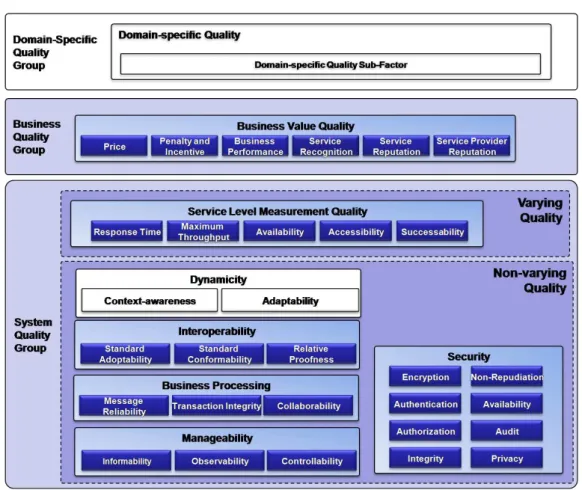
User QoS ontology
At the core of QoS-aware service composition is the issue of QoS-aware service selection, which enables the determination of services that are available in pervasive environments and can meet the user's QoS requirements. At the dynamic binding stage, one service (among those previously selected by QASSA) is bound to each activity in the user task.
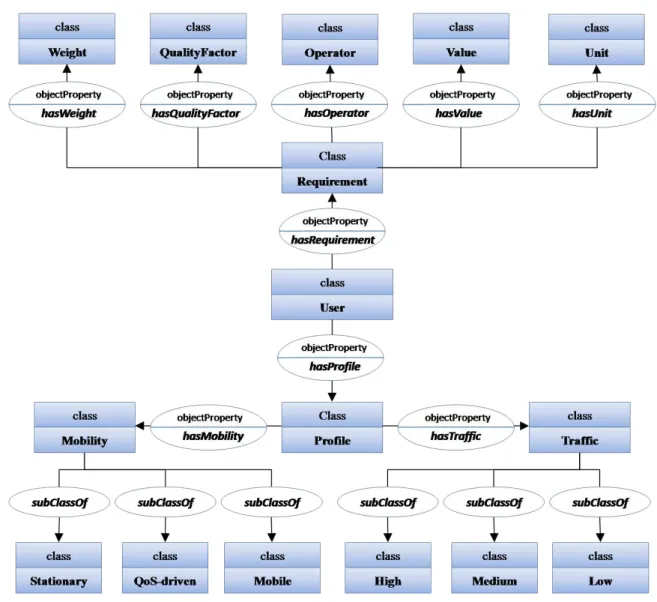
QoS model
How service composition is specified has a fundamental impact on QoS-aware service composition approaches in distributed environments.
Composition model
Each abstract activity Ai in the user task is associated with a set of concrete service candidates S = {si,1, si,2, ., si,mi} that can realize Ai. The question to be asked is which service should be accepted for each activity in the user's task so that the entire composition satisfies the user's QoS requirements U = Èu1, ., unÍ.
QoS aggregation
The QoS of a service composition QoSCi = ÈQ1, ., QnÍ is determined by aggregating QoS values of its constituent services QoSsi,k = Èq1, ., qnÍ. QoS aggregation is a complicated task that depends on both the considered QoS characteristics and the aggregation patterns underlying the aggregation. Each type of QoS properties can be aggregated differently with respect to assembly patterns (Seq, AND, XOR, Loop).
Design Rationale
We consider three types of QoS properties with respect to their inherent aggregation semantics: i) additive properties which can be aggregated using the + operator such as response time, ii) multiplicative properties which can be aggregated using the operator . .such as availability and reliability, and iii) properties that can be aggregated using the min and max operators. The objective of our algorithm is to select near-optimal service compositions, i.e., service compositions that satisfy the user's QoS requirements and provide as high a QoS level as possible.
Local Selection Phase
Preliminary Investigation
Indeed, most existing algorithms [Yu et al., 2007] use QoS auxiliary functions that aggregate all QoS properties of services. In our case, the n-dimensional Euclidean distance represents a QoS utility function that aggregates all QoS properties of services.
Local Selection in QASSA
The intersection of these clusters gives the services with the highest QoS values for all QoS properties. Literally, the QoS class QCr,e represents the set of services that have exactly e QoS properties out of n at the QoS level QLr.
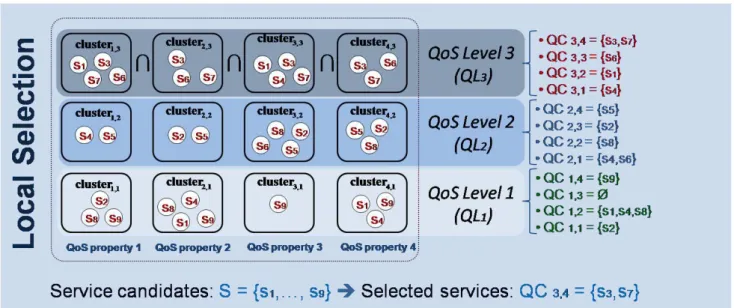
Global Selection Phase
This consequently yields several alternative service compositions ranked with respect to their overall QoS utility F which is defined as follows (lines 59 to 62 in 2). For example, in the example of Figure IV.3, the global selection yields four service compositions ÈC4,C2,C1,C5Í ranked according to their utilitiesF.
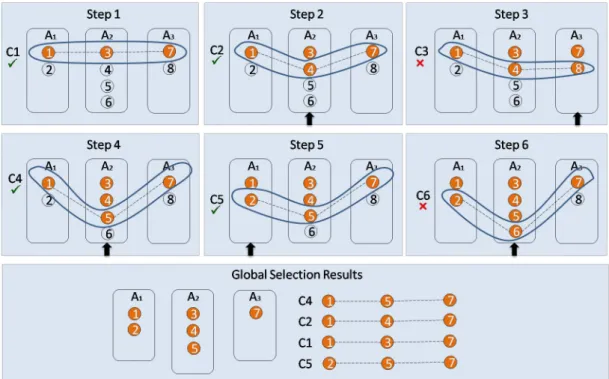
Computational Complexity Analysis
Indeed, a skyline service is a service that has the highest (i.e. best) value for one or more QoS attributes, while it may have very low values for the remaining QoS attributes. Similar to [Alrifai et al., 2008], the authors decompose global QoS constraints into local constraints using MILP.
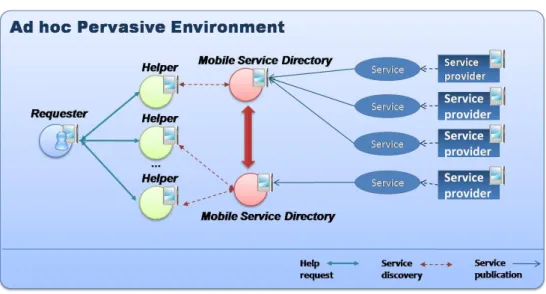
Global and Proactive QoS Monitoring
Global QoS monitoring provides a comprehensive view of the current service composition and evaluates its status against global QoS requirements. Global QoS monitoring enables prediction of violation of QoS requirements and implementation of expected adaptive measures (e.g. reassembly).
Service Substitution
The subdivision of G then represents an alternative abstract composition that allows the user task to be performed based on finer abstract activities. Formally, the user task behavior can be defined as an undirected labeled graph.
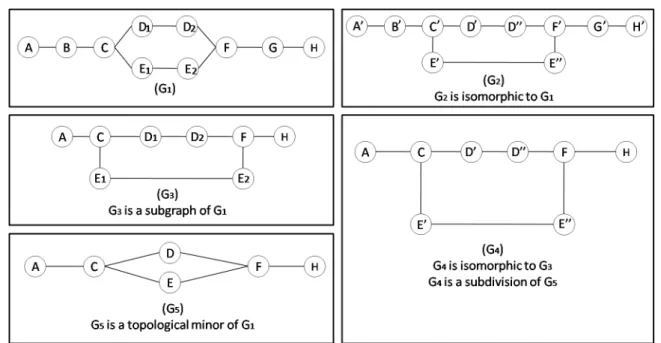
Overview
Assuming composition 1 is the abstract composition defined by the user, composition 2 shows how to change the order in which abstract activities are performed, e.g. ordering the book is delayed after ordering the mp3 player and headphones. Finally, the abstract composition number 5 combines both methods, for example, ordering the MP3 player and headphones is split into two activities and then ordering the book is performed.

Formal Definition
Based on the above description, we can say that the task class concept represents a set of abstract compositions that are functionally equivalent, i.e. they allow the same user task to be performed. Second, the user task is modified by merging one or more activities in Gf into coarse-grained activities.
Preliminary Verifications
Recall that node mapping only considers nodes associated with abstract activities. Both pre-verifications (i.e., node mapping and input/output verification) are performed recursively to verify the functional, input, and output correspondence between the failed subgraph and each alternative subgraph (obtained from the task class).
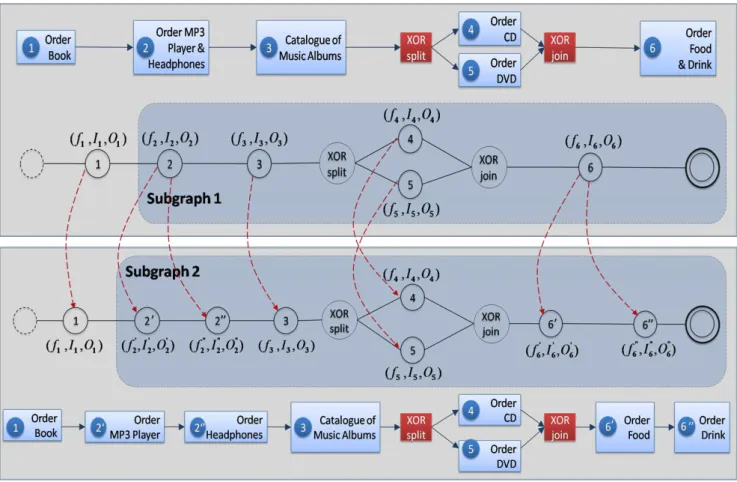
Extended Vertex Disjoint Subgraph Homeomorphism
Semantic vertex matching
Data constraints
To do this, we extend the injective-edge mapping performed during the determination of vdSH in order to take into account the data constraints. To this end, we first propose a definition of data binding, then define our scope on the injective edge map.
Particular vertex mappings
In [Paolucci et al., 2002] the authors define four values of semantic concept matching: Exact, PlugIn, Subsume and Fail (see Section 6.1 for details). Behavioral equivalence of services is also known in the literature as substitutability analysis [Ponge et al., 2010].
SemEUsE Architecture
Contribution to SemEUsE
QoS-enabled Composition
Reconfiguration
It is composed of a set of middleware services that provide semantically enabled capabilities: (i) the use of semantic service and task descriptions that combine functional, non-functional (eg QoS, security and context) and user profile aspects; and (ii) the ability to dynamically discover, select, compose, monitor, and reconfigure services at runtime while enforcing QoS. As already introduced, QASOM was initially developed as a part of the SemEUsE middleware, more specifically, it implements the QoS awareness aspect in SemEUsE.
QASOM Architecture
QoS-aware Service Composition Framework
The QoS-aware Service Composition Framework takes as input a user request that includes the description of the user's task and the set of global QoS constraints imposed on that task. The User Request Parser parses the user task specification and determines its underlying abstract activities and the set of global QoS constraints imposed on the entire task.
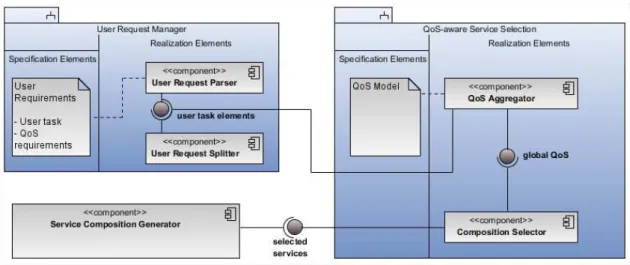
QoS-driven Composition Adaptation Framework
Preliminary Verifiers are responsible for performing the preliminary verifications (ie semantic vertex mapping and input/output verification) before performing the vdSH determination. The Behavioral Adaptation Manager coordinates the sub-components of Behavioral Adaptation (ie preliminary verifications and vdSH determination) to fulfill behavioral adaptation requests triggered by the Decision Engine.
Prototype Implementation
Specifying User Tasks
Nevertheless, Abstract Process is a general specification, covering various use cases and different degrees of abstraction. Below we provide a code snippet of the abstract BPEL related to the pervasive shopping scenario introduced in Chapter I.
Specifying Executable Service Compositions
Experimental set up
We further conduct experiments regarding the three aggregation approaches to study their impact on the timeliness and optimality of QASSA. In addition, we set global QoS constraints to different statistical values to analyze their impact on the timeliness and optimality of QASSA.
Performance of QASSA (the centralized version)
Impact of the Aggregation Approach
To this end, we set the number of QoS restrictions at 5, we vary the number of activities in the composition between 10 and 50, and we vary the number of services per activity between 50 and 200. As for the optimality of QASSA, we measure it while the number QoS Limits is set to 5, varying the number of activities in the compound between 5 and 10 and.
Impact of User QoS requirements
Consequently, setting user QoS requirements to Agg(m) and Agg(m+‡) (respectively, Agg(m) and Agg(m ≠‡) for negative QoS properties) can remove approximately 50% and 84.1% of service candidates, respectively. Figure VI.11 depicts the optimality of our algorithm associated with user QoS requirements set at m and m+‡ respectively.
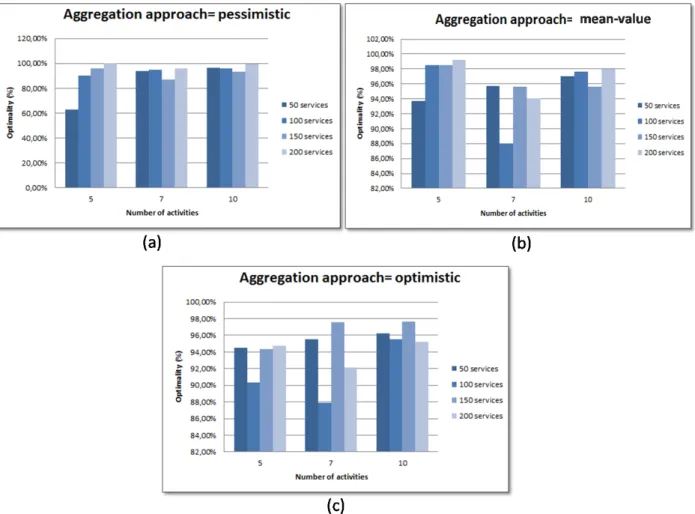
Performance of QASSA (the distributed version)
Thus, the running time presented in these experiments only concerns the local and global selection algorithms of the distributed version of QASSA. For local selection, the execution time is measured for an abstract activity (indeed, each helper processes local selection for an activity in the user task).
Performance of Transforming the User Task into a Behavioural Graph
The idea of QoS awareness involves (i) the establishment of a proper QoS model that enables the effective understanding and use of QoS, (ii) the consideration of QoS aspects of services during the composition and deployment of the user task, and (iii) adapting the performance of the user task with respect to QoS changes in pervasive environments. As part of the QASOM prototype, we developed the QoS ontologies of our model using the OWL-DL2 language.
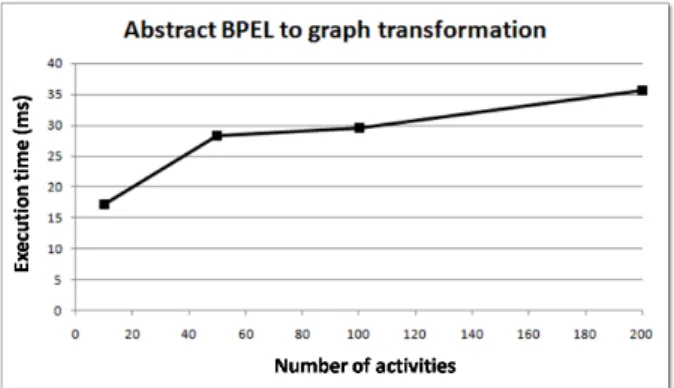
Short-term perspectives
Long-term perspectives
In Proceedings of the 9th IFIP WG 6.1 International Conference on Distributed Applications and Interoperable Systems. In PERCOM ’06: Proceedings of the Fourth Annual IEEE International Conference on Pervasive Computing and Communications.
Pervasive shopping scenario
Thesis overview
Taxonomy of QoS models
Taxonomy of QoS-aware service specifications
Taxonomy of QoS-aware service composition
Taxonomy of QoS-driven composition adaptation
QoS model overview
Overview the QoS Core ontology
Overview the Infrastructure QoS ontology
Overview the Service QoS ontology
Overview the User QoS ontology
QoS-aware Service Composition Approach
The local selection phase
An example of running the global selection algorithm in QASSA
Ad hoc pervasive environments
Illustrating graph definitions
Overview of the behavioural adaptation strategy
Bob’s shopping task and its equivalent labelled graph
Simplifying loop activities
Illustrating the Task Class concept
Illustrating the preliminary vertex mapping
SemEUsE ARchitecture
QASOM Architecture
QoS-aware Service Composition Framework
QoS-driven Composition Adaptation Framework
04 : Proceedings of the 13th International Conference World Wide Web on Alternate track papers & posters. In Proceedings of the Seventh IEEE/ACIS International Conference on Computer and Information Science (icis 2008).

Execution time while varying (a) the number of services per activity and (b)
Optimality measurements while (a) varying the number of services and (b) the
Execution time wrt to the (a) pessimistic, (b) optimistic and (c) mean-value
Optimality of the algorithm wrt to the (a) pessimistic, (b) optimistic and (c)
The normal distribution law
Execution time of the (a) local selection and (b) global selection of our distri-
Execution time of transforming abstract BPEL specifications into behavioural
